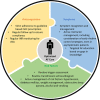Integrated Care in Atrial Fibrillation: A Road Map to the Future
- PMID: 33663224
- PMCID: PMC7982130
- DOI: 10.1161/CIRCOUTCOMES.120.007411
Integrated Care in Atrial Fibrillation: A Road Map to the Future
Abstract
Atrial fibrillation (AF) is the most commonly encountered arrhythmia in clinical practice with an epidemiological coupling appreciated with advancing age, cardiometabolic risk factors, and structural heart disease. This has resulted in a significant public health burden over the years, evident through increasing rates of hospitalization and AF-related clinical encounters. The resultant gap in health care outcomes is largely twinned with suboptimal rates of anticoagulation prescription and adherence, deficits in symptom identification and management, and insufficient comorbid cardiovascular risk factor investigation and modification. In view of these shortfalls in care, the establishment of integrated chronic care models serves as a road map to best clinical practice. The expansion of integrated chronic care programs, which include multidisciplinary team care, nurse-led AF clinics, and use of telemedicine, are expected to improve AF-related outcomes in the coming years. This review will delve into current gaps in AF care and the role of integrated chronic care models in bridging fragmentations in its management.
Keywords: anticoagulants; atrial fibrillation; chronic disease; delivery of health care; heart diseases.
Figures






References
-
- Wolf PA, Abbott RD, Kannel WB. Atrial fibrillation as an independent risk factor for stroke: the Framingham Study. Stroke. 1991;22:983–988. doi: 10.1161/01.str.22.8.983 - PubMed
-
- Wang TJ, Larson MG, Levy D, Vasan RS, Leip EP, Wolf PA, D’Agostino RB, Murabito JM, Kannel WB, Benjamin EJ. Temporal relations of atrial fibrillation and congestive heart failure and their joint influence on mortality: the Framingham Heart Study. Circulation. 2003;107:2920–2925. doi: 10.1161/01.CIR.0000072767.89944.6E - PubMed
-
- Kannel WB, Abbott RD, Savage DD, McNamara PM. Coronary heart disease and atrial fibrillation: the Framingham Study. Am Heart J. 1983;106:389–396. doi: 10.1016/0002-8703(83)90208-9 - PubMed
-
- Ott A, Breteler MM, de Bruyne MC, van Harskamp F, Grobbee DE, Hofman A. Atrial fibrillation and dementia in a population-based study. The Rotterdam Study. Stroke. 1997;28:316–321. doi: 10.1161/01.str.28.2.316 - PubMed
Publication types
MeSH terms
Substances
LinkOut - more resources
Full Text Sources
Other Literature Sources
Medical
Miscellaneous

